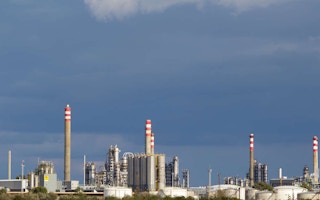International oil producers are bracing for carbon emission costs to soar to almost 10 times current prices in Europe, the world’s largest greenhouse gas market, as governments around the world escalate efforts to curb climate change.
Exxon Mobil Corp. (XOM), the biggest energy company by market value, is planning future capital investments on the assumption that it will be required to pay $60 a metric ton for carbon emissions.
That’s the highest among 11 U.S. and European corporations that provided figures in a report released today by CDP, a nonprofit that compiles environmental performance data for investors. Royal Dutch Shell Plc (RDSA) and BP Plc (BP/) are planning on $40, and Total SA (FP) anticipates a carbon cost of $34, according to the New York-based group formerly known as the Carbon Disclosure Project.
Those estimates compare to European Union carbon credits that closed today at 4.64 euros ($6.34), according to data compiled by Bloomberg. Companies involved in extracting and processing hydrocarbons such as crude oil and natural gas must ensure that multibillion-dollar investments remain profitable for decades under even the strictest environmental rules, said Deborah Gordon, a senior associate at the Carnegie Endowment for International Peace’s energy and climate program.
“Nobody builds infrastructure that costs tens of billions of dollars to last for a 5- or 10-year lifespan,” said Gordon, a former Chevron Corp. (CVX) chemical engineer. “These things are built to have 100-year lifetimes, so these companies have to think about what regulatory regimes will look like way beyond the next presidential election cycle.”
Google, Disney
Oil producers and power generators are the biggest users of internal carbon price estimates for long-term planning among the companies that disclosed specific figures, CDP said. Ameren Corp. (AEE), a St. Louis-based electricity and gas distributor, uses a $30 carbon benchmark. ConocoPhillips, the Houston oil explorer that spun off its refineries and chemical plants last year, employs carbon estimates that range from $8 to $46.
Exxon has been factoring future carbon costs into project planning since 2007, Alan Jeffers, a spokesman for the Irving, Texas-based company, said today in an e-mail.
“Although climate policies remain uncertain today, for the purposes of our business planning we assume that governments will continue to gradually adopt a wide variety of more stringent policies to help stem greenhouse gas emissions,” he said.
Other companies plugging carbon costs into planning assumptions include Google Inc. and Walt Disney Co., according to CDP. Google, the Mountain View, California-based online search provider, uses a $14 benchmark while Disney ranges from $10 to $20, according to the report.
Asymmetric risks
Oil and gas companies face “asymmetric risks” that regions currently without significant greenhouse-gas limits will impose costs or penalties in the future that may threaten the profitability of major capital investments such as offshore platforms or refineries, Guy Turner, chief economist at Bloomberg New Energy Finance in London, said in a telephone interview.
“We are in an incredibly uncertain environment right now with some countries going forward, some going back, so these companies are trying to future-proof their investments,” Turner said. “No one knows what’s going to happen with carbon policy over the next 10 or 20 years.”
Some countries are backtracking on climate-change policies, including Australia, which is debating legislation to repeal a carbon tax.
Rising seas
Carbon emissions from burning fossil fuels are expected to set off a chain reaction of higher temperatures, rising seas and violent weather systems, Sanford C. Bernstein & Co. said in a June note to clients. Among energy producers, BP and Shell are among the most at risk because of the large fuel-producing plants they own in low-lying areas close to oceans, Sanford’s Oswald Clint, Rob West and Iain Pyle said in the note.
Sea levels may rise as much as 2 meters (6.6 feet), swamping refineries, liquefied natural gas terminals, oil-tanker berths and even Shell’s Pearl gas-to-liquids plant in Qatar, which was built just 3 feet above sea level, the Sanford analysts wrote.
Sea levels already are on the rise, having climbed 15 to 20 centimeters during the 20th century, the Sanford analysts said, citing research published in the Journal of Geodynamics last year. More worrying, the analysts said, is that the rate has been accelerating in the past decade.
International companies
As more and more carbon is belched into the atmosphere and temperatures escalate, the world’s oceans are projected to rise another 0.5 to 2 meters by the end of this century, the Sanford analysts said, citing estimates compiled by the National Research Council, which advises the U.S. government on scientific matters.
“Companies that have international operations are especially astute to carbon pricing as a response to the regulatory environments in which they operate, such as Europe or Australia, where GHG emissions reductions are mandatory and covered by mandatory cap-and-trade programs or carbon taxes,” the CDP said in its report.










